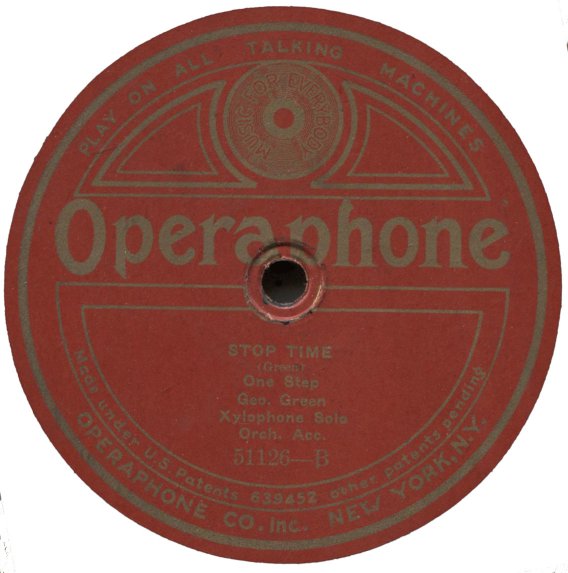
“Stop Time”
George Hamilton Green, xylophone with orchestral accompaniment
(Operaphone 51126-B) January, 1920
George Hamilton Green was one of the foremost xylophone artists of the early 20th century. He had a large output of records, recording on his own and in conjunction with his equally famous xylophone-playing brothers.
Green was also a ragtime composer and the author of the song he performs here.
Recorded in January 1920, this is probably the oldest recording in Radio Dismuke’s playlist. While the overwhelming majority of the station’s selections were recorded between 1925 and 1935, I do include recordings from as early as January 1920 and as late as December 1939 to the degree I feel they are a good fit. So, this one came close to being on the wrong side of the hard cutoff point.
I was actually on the fence about whether this recording was a good fit for the station, as it has much more of a 1910s style and sound than a 1920s one. But I also know that there are people in the audience who share my enthusiasm for xylophone performances.
The record itself is on a relatively rare label. While Operaphone dates back to 1916, they only made records of this variety from 1919 to 1920.
The grooves on this record are a 45-degree “universal cut” that is a hybrid between the lateral groove format of standard 78 rpms and the vertical groove format used on Edison, as well as early Pathe, Vocalion, Gennett, and OKeh discs.
Universal groove records were first introduced by Emerson in 1916 with the intent that they could be played on any phonograph, regardless of whether it was designed to play lateral or vertical records.
While such records technically play vertically and laterally, they usually don’t do so very well. The volume tends to be low when played vertically, and the sound quality is often fuzzy. They tend to sound better when played laterally, but they still sound less than optimal when played on vintage machines.
The secret to successfully playing and transferring such records is to play them laterally on a modern turntable with a stereo cartridge through the right channel only. In most cases, the left side of the groove on such records is noisy and has significantly lower sound quality than the right side of the groove.
In 1919, the patents for the lateral recording process controlled by Victor and Columbia expired. Soon afterward, all the record labels that had been issuing vertical and universal cut records began issuing lateral records, with the sole exception of Edison, which only began making them in the final months of its existence in 1929.
At this period, Operaphone did not have its own recording studios but rather purchased rights to reissue material from Pathe. The same year this record was made, Pathe introduced its own line of lateral records branded as Pathe Actuelle. For the next couple of years, new Pathe recordings were issued in both vertical and lateral formats.
This same recording by George Hamilton Green on universal cut Operaphone can also be heard on Pathe on both vertical disc number 22276 and on Pathe Actuelle lateral disc number 022276. It can also be heard on Empire 51126. Empire was a small label that purchased pressings from Operaphone and issued them under its own name.
The technical challenge of issuing the same recording on different types of disc formats is that a master disc recorded in one format cannot be used to press records of a different format. But, by this time, Pathe had long since found a way to overcome that challenge in Europe, where it had been issuing copies of the same recording in both disc and multiple-cylinder formats.
Pathe’s solution was to record all of its material onto an oversized, rapidly spinning cylinder. The cylinder’s large size and fast speed increased fidelity. Pathe then used a specially designed pantograph device to dub a copy of the cylinder recording to new masters in whatever groove format was desired.
Some sources suggest that universal cut recordings on Operaphone were not dubbed directly from Pathe’s master cylinder but rather from the vertically cut master that had been dubbed from the master cylinder.
If this were indeed the case, then issues of this recording on Operaphone and Empire would be third-generation copies as opposed to second-generation copies on both vertical and lateral Pathe discs.
On the other hand, based on the Operaphone records I have in my collection, their discs seem to have been made of high-quality material and have extremely quiet surfaces compared to Pathe Actuelle records of that same period, which are often quite noisy.
